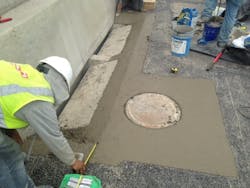Cutting a big job down to size
State Highway 183, from Euless to Dallas/Fort Worth, Texas, underwent a major reconstruction in 2014, a project totaling $1.6 billion. On projects of this size, even small changes can lead to a great deal of extra work, and such was the case when an unexpected grade change was required to correct drainage issues.
“It was a surprise— the road was raised up to four inches, after utility manholes had been installed,” explained Jonathan White, operations manager at Cheyenne Construction, a concrete subcontractor for the project. “That meant that 300-400 manholes needed to be uncovered, and raised to grade—that is a lot of work.”
Raising this many manholes could have added weeks to the completion timeline, not to mention higher costs and many more lane closures than had been anticipated. Fortunately, Cheyenne Construction found a manhole raising solution that was brand new to them, cut costs and time dramatically. The new solution proved to be durable and more than acceptable to lead contractor Bluebonnet Contractors and to the project owner, the Texas Department of Transportation (TxDOT).
A Better Way
White says that a manhole raising method based on custom sonotube forms was considered, but “it would have taken a long time to do it that way.” So he started looking for alternatives.
“When we started to look into possible solutions, manhole risers from American Highway Products, almost right away appeared, to be the right method for us,” White said. “We hadn’t used them before, but they directly addressed our need, had a good reputation, and certainly seemed to be fast to install and cost-effective.”
Still, the risers were new to Cheyenne and given the size of the project, amounted to a big bet on a new product. To satisfy themselves and other stakeholders, Cheyenne decided to test the solution on just three manholes, before committing to several hundred.
American Highway Products Pivoted Turnbuckle Manhole Risers are heavy duty galvanized steel rings that can be slipped into existing manhole frames, then the turnbuckle is tightened with a screwdriver (which applies thousands of pounds of force) to fit snugly—they seat well even in worn or out of round rims. The riser, now at grade, becomes a new rim for the original manhole lid.
On Highway 183, the plan was to saw cut a 4-ft square around the manholes, remove the covering asphalt, set the risers, then pour new concrete around the lid and new riser, leaving the manhole and a neat concrete border, both flush with the new asphalt grade (this was due to the surprise nature of the work—adjustable risers are usually set just before final paving lifts). The three test manholes proved that the method was practical; total time to raise the manholes, with a four-man crew, was about three hours, and installing the risers was less than ten minutes of that. “Anything else would have taken two to three times as long,” White said.
The risers are ordered in precise, custom sizes to fit any rim and match grade precisely. They can also be stacked if needed, a fact that Cheyenne leveraged to their advantage.
“All the manhole rim diameters were the same, but the asphalt varied from a little over an inch up four inches,” he explains. “So, we ordered 1.5-in. and 2.5-in. frames, and combined them to match different pavement thicknesses.”
Crews were able to adjust the concrete final grade about half an inch as needed, and the risers can also be adjusted a bit vertically, before tightening. That meant the two different risers could be stacked together to match pavement thicknesses of three inches or more, and individual risers could be used in thinner pavement. TxDOT inspected visually.
“It was very convenient, and we were able to match grade at every manhole,” White said. “They all worked perfectly.”
And they were convenient to order and use. White would typically establish lead times, and order in batches of 30 to 40—in all, 556 were used. Since one person can handle a riser easily, transporting to site was not a problem, and overall using risers is safer than manual raising methods because strain injuries are less likely, and traffic exposure is reduced.
All of the manholes are now set, and some have been in place and bearing traffic for several months. There have not been any failures.
“They’re heavy duty ribbed steel,” White said. “They’re not going anywhere.”
